Our most recent market study is out, this time analysing 175 of Burgundy’s finest wines. Last week’s blog gave an overview of the study’s key findings. This week we take a deeper look into one of the upward trends, exploring some of Burgundy’s best price performers.
While it is impossible to argue the position of Domaine de la Romanée-Conti at the top of the Quality and Brand leaderboards, a greater mix of producers excel in long-term price performance. Lalou-Bize Leroy’s Domaine d’Auvenay is a frequent and expected feature within the top price performers, but the list is not without surprises.
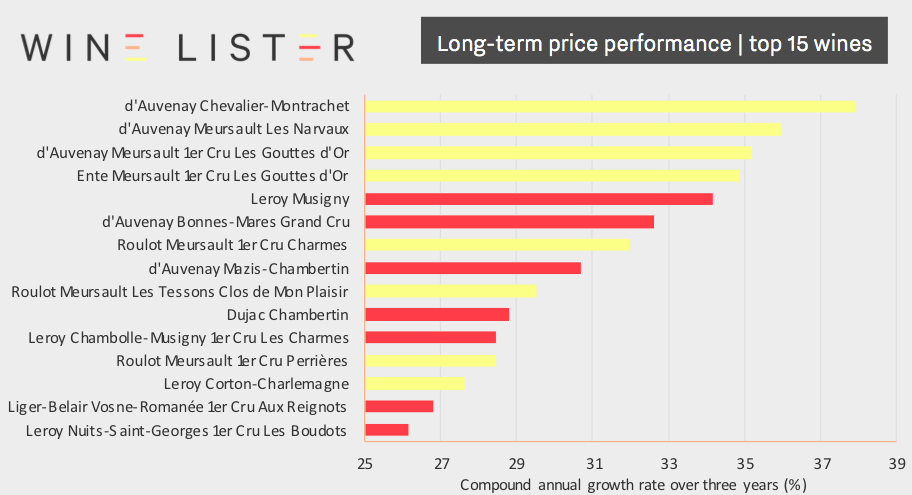
Arnaud Ente, while well known by those in the trade, is a quieter name in the global wine world. What Ente lacks in brand presence he makes up for in exceptional quality. Vines, notably his enviable Meursault plots, tend to be harvested late, giving wines their signature opulence. With a Quality score of 909 and a 3-year compound annual growth rate (CAGR) of 34%, Ente’s Meursault Les Gouttes d’Or is one of the best performing whites in Burgundy and the best 5-year price performer.
The Meursault village as a whole steals the show on price performance, accounting for 6 of the top 10 wines in the Economics score-criterion. Domaine Roulot, another producer flying slightly under the radar of Burgundy’s biggest brands also demonstrates strong long-term price performance across all three of their Meursault cuvées.
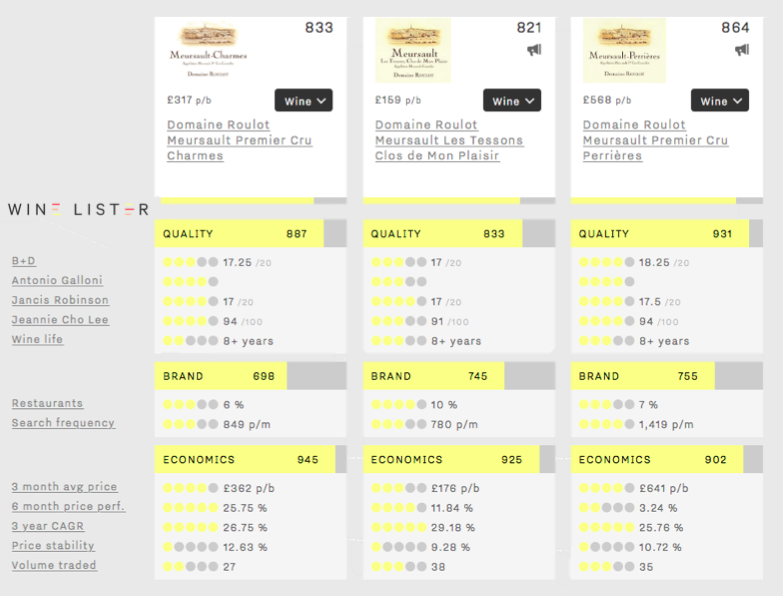
Meursault is not the only white village on the up. According to our Founding Members’ survey, which accompanies the Burgundy market study, the popularity of Saint-Aubin is increasing. Whether searching for the highest quality or the best value, it seems the white vineyards of Burgundy are the places to be this year.
You can read about more Burgundy trends in the full Burgundy market study by subscribing here. Alternatively, a preview of the first 15 pages is available here.
Today marks the close of a busy week of Burgundy 2016 en primeur tastings, with offer prices largely stable on 2015 despite tiny volumes, thanks to the more generous 2017 in the wings. However, prices have been escalating in the secondary market for several years now, with eight of the region’s top wines averaging more than £3,000 per bottle). Eyewatering, yes, but as illustrated in our recently published study, the majority of the region’s top wines are priced between £100 and £500.
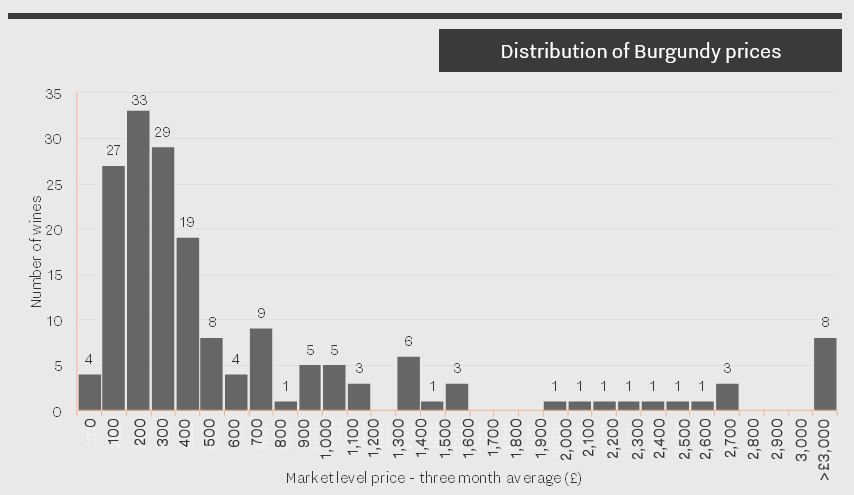
To mark this week’s Burgundy en primeur tastings, the latest Listed section picks out the top five red Burgundies priced under £300 per bottle by Wine Lister score. With an outstanding average score of 913 – putting them amongst the very strongest on Wine Lister – and four of the five achieving Buzz Brand status, these wines are worth the price tag.
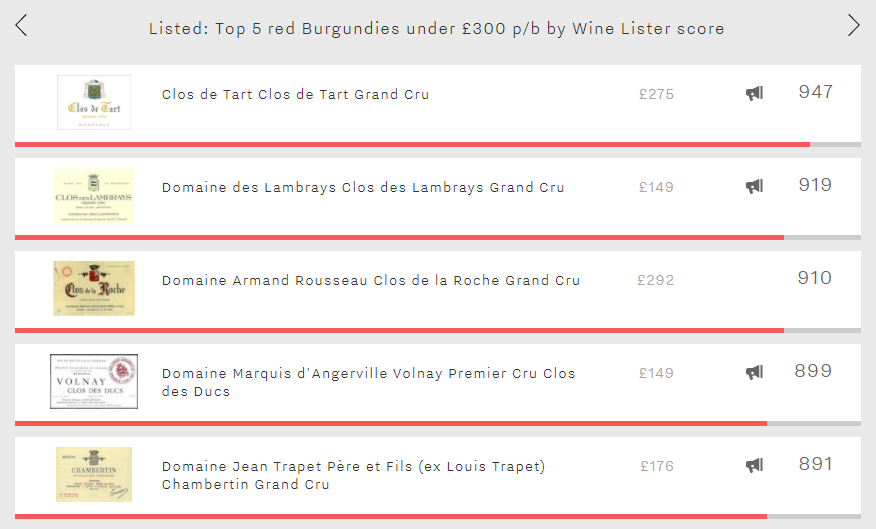
Leading the way is Grand Cru monopole Clos de Tart with a score of 947. Recently acquired by Artemis Domaines – Latour owner François Pinault’s holding company – it achieves the best Brand and Economics scores of the group (956 and 964 respectively), and is just pipped into second place in the Quality category by Trapet Père et Fils Chambertin Grand Cru (932 vs 940). Its price has increased 9% over the past six months, and now at £275, it looks like it won’t qualify for this group much longer!
Next comes Domaine des Lambrays Clos des Lambrays – part of LVMH’s portfolio since 2014 – with a score of 919. Alongside Marquis d’Angerville Volnay Premier Cru Clos des Ducs, this is the cheapest (or least expensive) of the group (c.£150 each). It enjoys its best score in the Brand category, with the group’s highest level of restaurant presence (25%), and the second-best average monthly online search frequency (5,079).
In third place is Rousseau’s Clos de la Roche Grand Cru with a score of 910. At almost £300 per bottle, it is the most expensive of the group, contributing to its boasting the best score in the Economics category (937). It is also partner critic Jeannie Cho Lee’s favourite wine of the group; she awards it a score of 95/100 on average.
Dropping just below the 900-point mark are Marquis d’Angerville Volnay Premier Cru Clos des Ducs and Trapet Père et Fils Chambertin Grand Cru (899 and 891 points respectively). They display very different profiles. The latter leads the Quality category, with the former lagging 60 points behind (still with a very strong score of 879). However,Trapet’s Chambertin struggles in other categories, with the group’s lowest scores for Brand and Economics (867 and 823). Meanwhile, thanks to the group’s strongest long and short-term growth rates, Marquis d’Angerville’s Volnay Clos des Ducs enjoys an excellent Economics score (939) – the second-best of the five.
If you’d like to discover more about Burgundy and its top wines, then click here if you are a subscriber to view the full regional study, or here to see a preview if you haven’t yet subscribed.
Wine Lister’s holistic, dynamic rating system tracks a wine’s performance over time. By constantly analysing a wine’s brand strength and economic performance, as well as updating its Quality score as it is retasted by our partner critics, Wine Lister’s ratings evolve over time, as demonstrated by our new score history tool.
Wine Lister’s Economics score is a perfect case in point. Reacting to the very latest market data, it analyses a wine’s performance across several criteria: three-month average bottle price; short and long-term price performance; price stability; and liquidity. A strong showing across these criteria is what defines the five wines in this week’s Listed section – Bonnes-Mares’ top wines by Economics score.
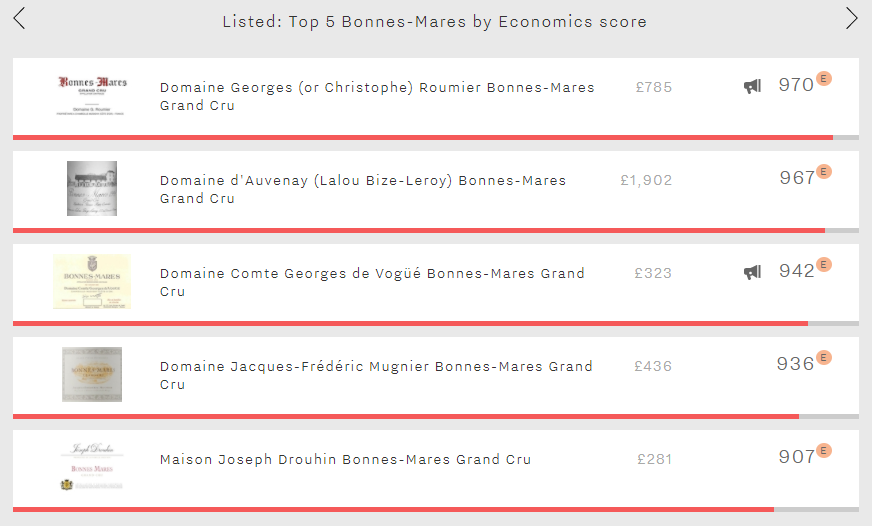
Whilst all five achieve Economics scores that put them amongst the very strongest on Wine Lister, it is Domaine Georges Roumier’s Bonnes-Mares that leads the way with an outstanding score of 970. It is the most liquid of the five, its five top-selling vintages having traded 414 bottles over the past four quarters.
In second-place is Domaine d’Auvenay’s Bonnes-Mares (967). Underlining the Queen of Burgundy’s continuing surge in demand, it has a remarkable three-year CAGR of 35.6% (nearly double that of Domaine Jacques-Frédéric Mugnier’s Bonnes-Mares, its closest rival in that criterion). Its price is the highest of the group by a considerable distance, at £1,902.
Domaine Comte Georges de Vögué fills the third spot with its Bonnes-Mares’ Economics score of 942. One of the group’s two Buzz Brands, it is the second most-traded of the five (327 bottles), and has strong short-term price performance, its price having increased 11.2% over the past six months.
The Bonnes-Mares from Domaine Jacques-Frédéric Mugnier and Maison Joseph Drouhin fill the last two spots. Whilst they display similarly modest levels of liquidity (having traded 63 and 68 bottles over the past four quarters respectively), Mugnier leads Drouhin thanks to its considerably higher price (£436 vs £281) and superior long-term price performance (three-year CAGR of 18.2% vs 13.9%).
And thanks to Wine Lister’s approach, these scores will continue to change over time, meaning that they are always relevant and reflect the wine’s evolving position in the market.
Having ushered in Autumn with some of Northern Italy’s foremost brands, our Listed section continues its whirlwind tour of the world’s great wine regions in the Rhône. Home to some of France’s most illustrious producers, the Rhône tends to garner the most attention for its reds. However, its whites are well worth a mention too, and don’t require quite the same budget. Here we look at the region’s five most expensive dry whites.
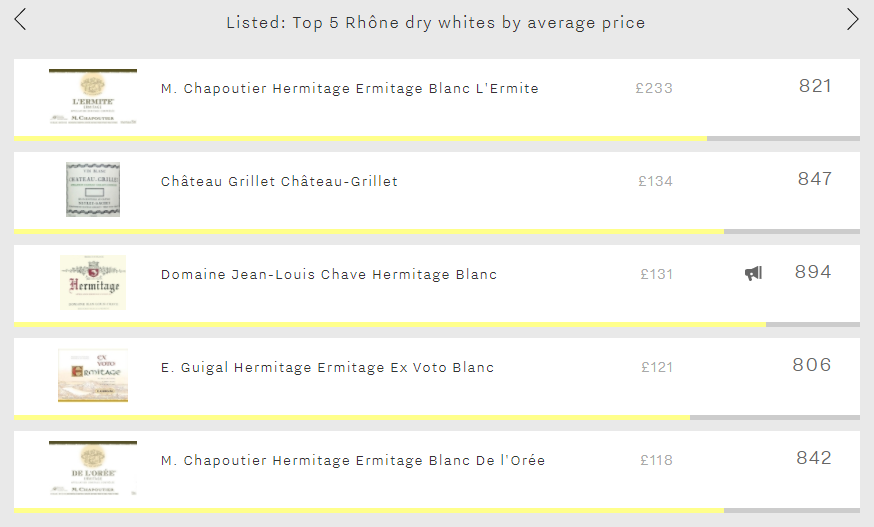
Interestingly, all five wines are from the Northern Rhône, with Hermitage home to four of them. M. Chapoutier Ermitage Blanc L’Ermite tops the table. The first of two wines from Michel Chapoutier, at £233 per bottle it is by far the most expensive of the five. It also outperforms the others in the Quality category – with an outstanding average score of 961.
Château Grillet is the only wine of the five not produced in Hermitage. This 100% Viognier from the eponymous monopole (one of only a handful of single-estate appellations in France – can you name the others?) commands an average price of £134. It enjoys by far the best Economics score of the group (824), thanks to exceptional short-term price performance – its price having risen 22% over the past six months.
Snapping at its heels is similarly priced Domaine Jean-Louis Chave Hermitage Blanc. It achieves an average Quality score of 954, just six points behind that of its red counterpart. It is also the only Buzz Brand in the group, and enjoys the best Brand score (918).
Around the £120 mark, E. Guigal Ermitage Ex Voto Blanc and M. Chapoutier Ermitage Blanc De l’Orée fill the fourth and fifth spots. Underlining the outstanding quality of the group, they both achieve scores of over 900 in the category, ranking them amongst the very strongest on Wine Lister.
If we compare the quality to price ratio of these five whites and the Rhône’s five most expensive red wines, the whites look good value. Whilst the reds achieve a slightly better average Quality score (957 vs 919), you pay a significant premium for them – their average price is over 4.5 times higher than that of the whites (£671 vs £147).
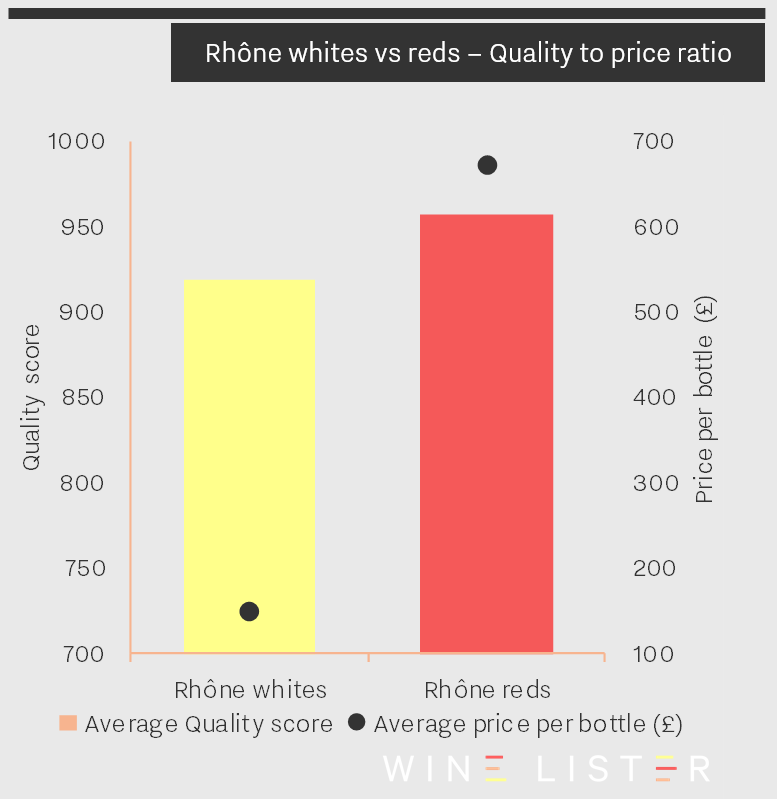
In an attempt to squeeze every last drop out of summer, this week’s Listed section features Wine Lister’s top 5 rosés by Quality score. Whilst the Côte d’Azur might seem a long way away, these five Provençal wines serve as a reminder of warmer climes and long sunny days.
Wine Lister’s Quality score measures a wine’s performance across two criteria – critics’ scores and ageing potential. Whilst these wines perform relatively well with the critics, they are not built with longevity in mind, and have an average predicted drinking window of just three years – compared to 17 and 16 years respectively for the top five whites and reds for Quality.
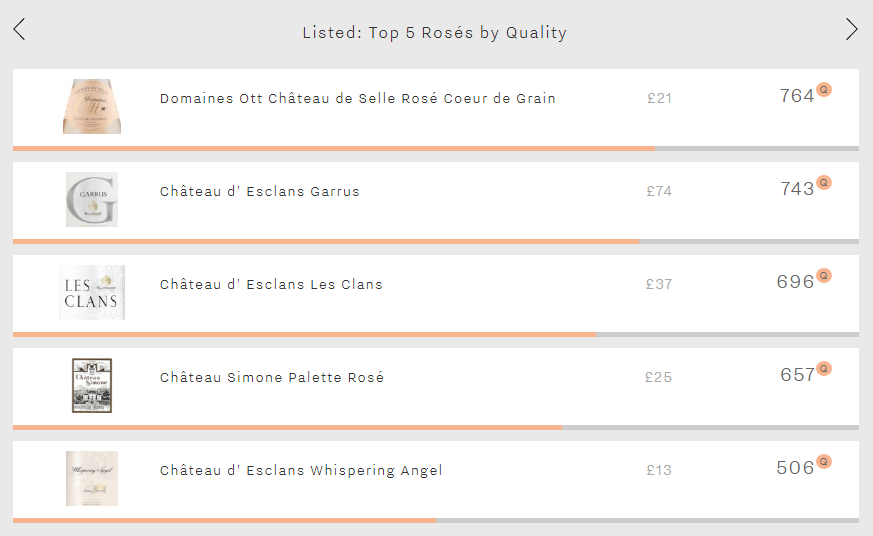
Domaines Ott Château de Selle Rosé Coeur de Grain tops the table with a very strong Quality score of 764. Currently priced at around £21 per bottle (depending on the retailer), it is the second-cheapest of the five, and represents excellent value for money.
Garrus, the first of three wines from Château d’Esclans, comes next with a Quality score of 743. At £74 it is by far the most expensive of the group – over twice as expensive as is its close relative Les Clans, with a Quality score of 696. Both these wines divide the critics, performing well with Antonio Galloni and Jancis Robinson, but less favoured by Bettane+Desseauve.
In fact, the French duo are considerably less enamoured with these five rosés than Jancis Robinson in general. Perhaps still rosé has a way to go before it is considered a serious vinous offering in France.
Château Simone Palette Rosé fills the fourth spot with a score of 657, followed by a third wine from Château d’ Esclans – Whispering Angel. Whilst it has a modest Quality score of 506, and is by far the least expensive of the group, it has by far the best Brand score (805). Proof that formidable branding can propel a wine beyond where its intrinsic quality level might suggest (though we certainly wouldn’t turn our noses up at a chilled glass of Whispering Angel on a sunny day like today).
One of Wine Lister’s four Indicators, Value Picks identify the wines and vintages which have the best quality to price ratio, with a proprietary weighting giving more importance to quality, thus giving the finest wines a look-in.
With the latest price data in, 28 new wines have recently qualified as Value Picks. While Value Picks are calculated using a three-month average bottle score for accuracy (in order to take into account any price fluctuations), we have shown the current price per bottle below for ease of comparison. Please note that the price shown is excluding duty and VAT, and often reflects prices available only when purchasing a full case:
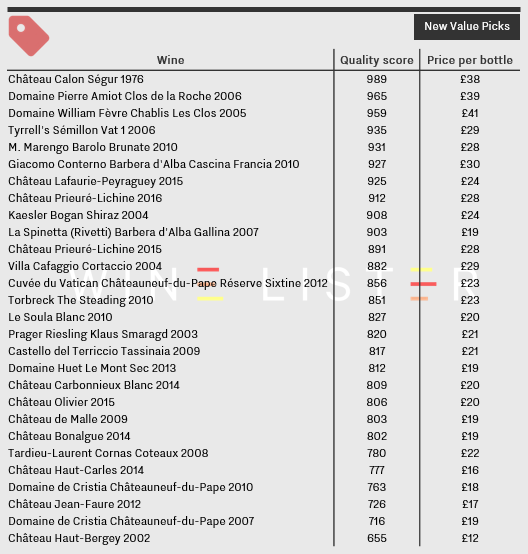
Bordeaux dominates the new Value Picks, filling 11 of the 28 spots. Margaux’s Prieuré-Lichine seems a particularly keenly-priced brand at the moment, with both its 2015 and 2016 vintages now Value Picks. With Wine Lister Quality scores of 891 and 912 respectively – very strong and amongst the strongest on Wine Lister’s 1000 point scale – and both priced under £30, they represent excellent value buys. Within Bordeaux, Pessac-Léognan is home to the highest number of new Value Picks. Of those, two are white, with Château Carbonnieux Blanc 2014 and Château Olivier 2015 achieving very similar Quality scores (809 and 806 respectively), and each priced at just £20.
The other wine to feature twice in the latest update is Domaine de Cristia Châteauneuf-du-Pape, with its 2010 and 2007 vintages. The former, which achieves a Quality score of 763, is available at just £18 per bottle. With plenty of life left in it, it looks like a great buy.
Three Piedmontese wines recently qualified as Value Picks – M. Marengo Barolo Brunate 2010, Giacomo Conterno Barbera d’Alba Cascina Francia 2010, and La Spinetta (Rivetti) Barbera d’Alba Gallina 2007. All three achieve powerful Wine Lister Quality scores of over 900 points. You might buy Giacomo Conterno’s wines to impress – the Barolo Cascina Francia is a Wine Lister Buzz Brand, but also averages £157 per bottle. If you’re looking for something more appropriate for a weeknight, the 2010 vintage of the same producer’s Barbera d’Alba, priced at just £30, would be an excellent Value Pick – a perfect example of how Wine Lister’s indicators can help you find the right wine for any situation.
Wine Lister’s Economics scores are based on a variety of price and liquidity metrics, including a wine’s three-month average bottle price, six-month price performance, and three-year CAGR. This week’s newly updated Listed section features the five top-scoring Australian wines by Economics score. Noticeably, all are red, and red wines outperform for Australia in this category (the top white, Leeuwin Estate Art Series Chardonnay, has an Economics score of 498, its top traded vintages only trading 10 bottles in auction over the past year). While there is quite a difference in points between the first and fifth wine on today’s list, all are considered very strong (750–900) or among the strongest (900+) wines in Wine Lister’s database.
Several of Australia’s best-known producers feature in our top five, including Penfolds, which accounts for the top two entrants: Penfolds Grange and Penfolds Bin 707 Cabernet Sauvignon. While both wines excel on three-month average bottle price and three-year CAGR, Penfolds Grange is particularly strong for liquidity, its top five trading vintages having traded 626 bottles over the past four quarters.
The third wine on this list, Torbreck Run Rig, experiences good trading volumes but has the lowest three-year CAGR of the five (3.27%). Fourth place goes to Henschke Mount Edelstone Shiraz, which is the lowest in price and sees fewer bottles traded than the others, but has an excellent six-month price performance of 11.88% and good price stability. Finally, the list is completed by Grant Burge Meshach Shiraz, which has one of the higher three-year CAGRs, at 6.4%.
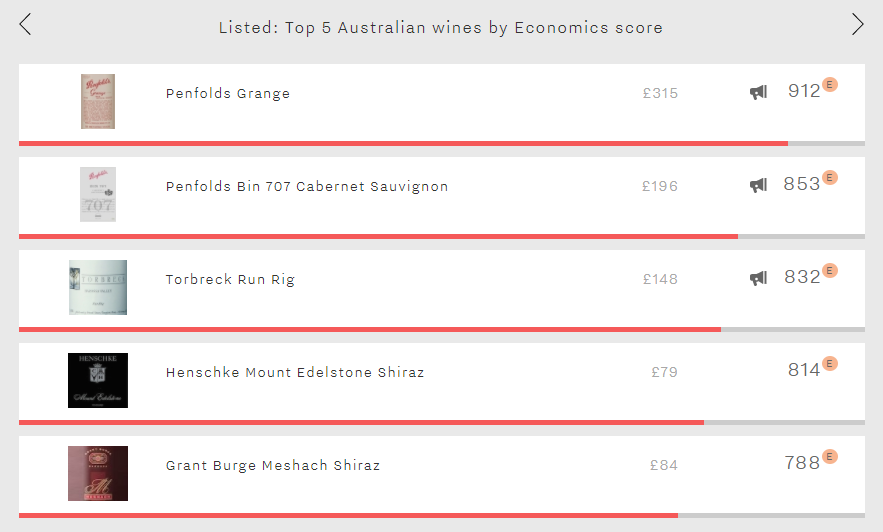
Don’t forget – if you’re not yet a subscriber to Wine Lister, you can still fully explore this week’s five Listed wines, and those for the previous four weeks, via the homepage.
This week’s listed section looks at the five most expensive Californian wines. Unsurprisingly, the list comprises five cult Napa reds, all with small annual productions helping to fuel a healthy supply and demand ratio that keeps consumers thirsty and wanting more.
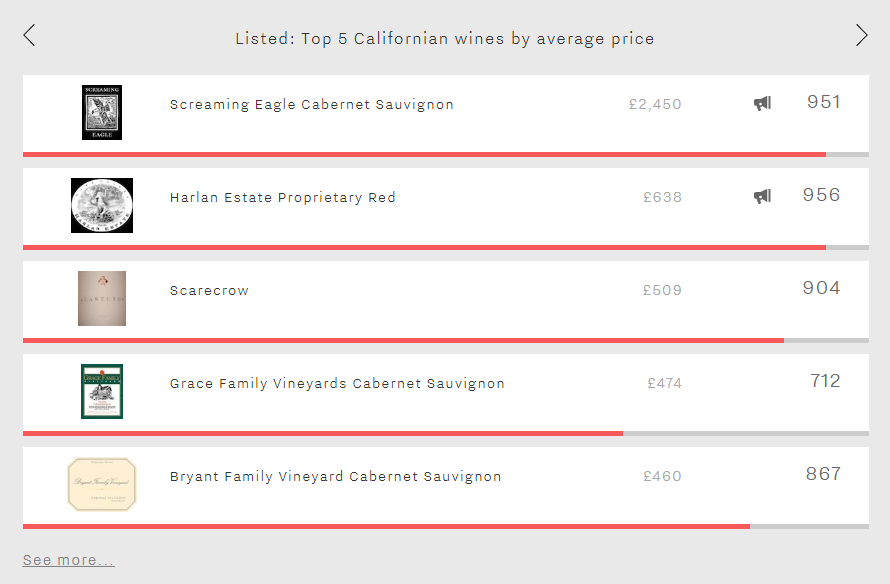
Leading the way is Screaming Eagle, averaging c.7,800 bottles per year. At £2,450 per bottle, it is the 12th most expensive wine in Wine Lister’s database, just £27 below DRC La Tâche.
Harlan, the third highest-rated Californian wine overall, has an average annual production of c.21,600 bottles, and is the region’s second most expensive wine. At £638, it is available at nearly a quarter of the price of Screaming Eagle.
The next three wines all have lower production volumes than Harlan. At £509, Scarecrow has a similar price point to the likes of Lafite (£522) and Masseto (£524). Fourth-placed Grace Family Vineyards Cabernet Sauvignon achieves a Wine Lister score of 712, considerably lower than the others, but again low production volumes (c.6,000 bottles a year) help it to achieve its hefty price tag of £474. Bryant Family Vineyard Cabernet Sauvignon fills the fifth spot at £460 per bottle.
Produced on far greater scales than these five, Dominus and Ridge Monte Bello, Wine Lister’s two overall top-scoring Californian wines, do not make the top five most expensive. The trendline on the chart below confirms the negative correlation between price and production:
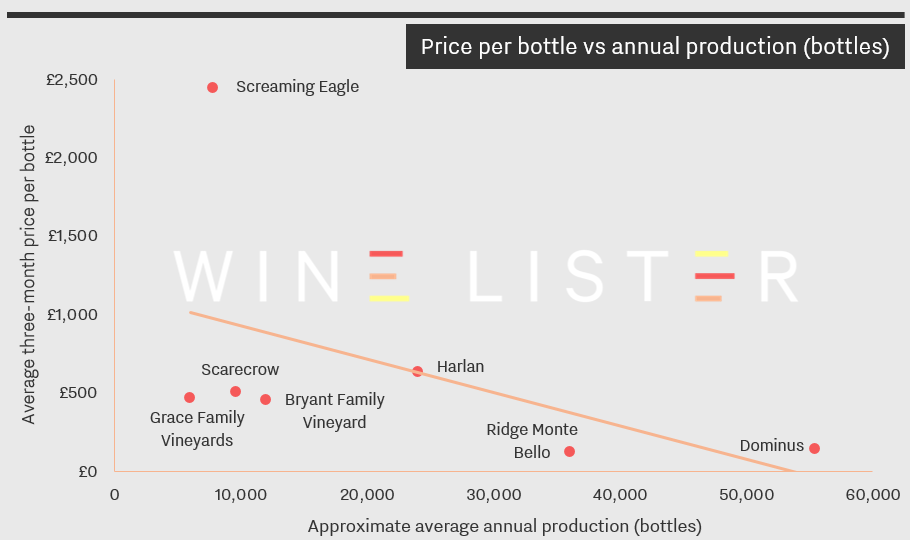
Remember that even if you don’t currently have a Wine Lister subscription you can access all the underlying data behind these five wines as well as those featured in other Top 5s, giving you an insight into the wealth of tools at our subscribers’ disposal.
Following on from our recent blog on the relationship between price and quality for seven leading wine regions, today we turn our attention to the role that brand strength plays on price for those same regions. The chart below compares the regions’ average three-month market price to their average Brand scores, using the same 50 overall top scoring wines in each region as in the previous post.
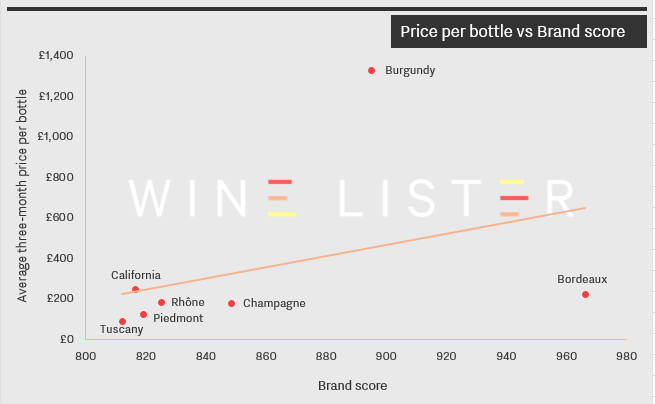
Bordeaux’s crus classés enjoy unassailable brand strength, a product of the success of the region’s classification system and the fact that its châteaux have enjoyed global renown for centuries. If you want brand for your buck, look no further.
Conversely, Burgundy’s extraordinary prices far exceed the level of brand clout commanded by its top crus. Its top wines trail the average Brand score of Bordeaux’s by 7%, but sell for nearly six times as much. This suggests that quality, and perhaps small production levels, play more of a part in the region’s prices.
The five remaining regions are more evenly matched. Tuscany’s wines have both the lowest average Brand score and the lowest prices, followed closely by Piedmont. Meanwhile California’s top 50 wines, which have the second-lowest average Brand score, command the second-highest prices. Top wines from the Rhône and Champagne command similar prices to their Bordeaux counterparts, but with average Brand scores more than 100 points lower.
In today’s blog, we’ve taken a look at the relationship between price and quality for seven leading wine regions. The chart below compares the regions’ average three-month market prices to their Quality scores, with the data calculated from each region’s 50 best-scoring wines (in terms of overall Wine Lister score).
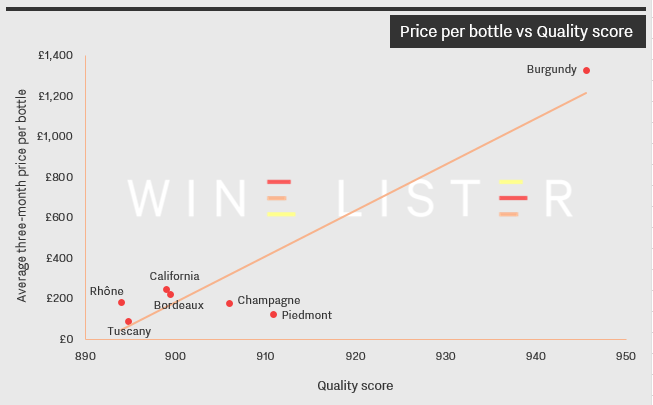
While six regions are clustered relatively close to each other, Burgundy finds itself at the extreme top end of the scale: its wines outperform on quality and have the prices to match. The top 50-scoring wines in Burgundy average a whopping £1,330 per bottle, driven by the likes of DRC La Romanée-Conti at £10,776 and Domaine Leroy Musigny at £7,805.
The Rhône’s wines have the lowest average Quality score but not the lowest prices: at £188 per bottle on average, they are the fourth most expensive of the group. California and Bordeaux display a very similar profile, appearing just above the trendline, indicating that these wines command high prices not simply on account of quality – brand also plays a part.
Champagne and Piedmont, meanwhile, fall below the line, suggesting that as regions they tend to offer value for money. Piedmont’s ranking is particularly impressive: second only to Burgundy in terms of average Quality score, its wines are available for a tenth of the price on average.













